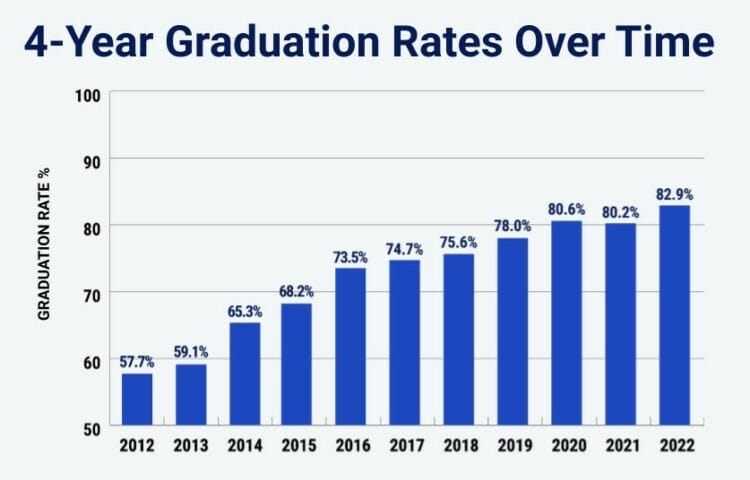Highest-Ever Graduation Rate of 83.8 Percent Propelled by Gains from Black Students; District’s One-Year Dropout Rate of 3.8 Percent is All-Time Low
Chicago Public Schools CEO Pedro Martinez recently announced the District’s record-high five-year graduation rate of 83.8 percent, up by nearly 27 percentage points from 2011 when the rate was 56.9 percent. The four-year rate saw a similar gain, increasing 26 percentage points in the same time span and remaining nearly level since last year at 80.2 percent for the Class of 2021. Increased graduation rates among students of all racial groups led to the overall gain, bringing the District closer to its Five-Year Vision goal of reaching a 90 percent graduation rate by 2024.
“This is a wonderful sign of our District’s progress,” said CEO Martinez. “The last time I worked for CPS, our graduation rates were nowhere near where they are now, and I am so proud of each and every Class of 2021 graduate and the many teachers and family members who supported them, especially amid this global pandemic. We are excited and ready to ensure more students reach this milestone, equipped and ready to succeed in college and careers.”
CEO Martinez joined District and school leaders as well as students at Amundsen High School Thursday afternoon to celebrate the gains and encourage continued growth across CPS. Principals from neighborhood high schools with the top 10 graduation rates for the Class of 2021 also joined the event which featured musicians from the Amundsen High School Orchestra and a future Class of 2022 graduate.
Strong Growth From Priority Demographics
Graduation rates for the District’s four largest racial demographics—Latinx, Black, White, and Asian—all increased this year. In particular, strong progress from Black students, a 2.1 percent increase for Black males and a 1.8 percent increase for Black females, helped contribute to the District’s overall record-high graduation rate. The graduation rate for Latinx males increased by 0.3 percentage points, and the graduation rate for Latinx females increased by 0.5 percentage points.
While an opportunity gap between the five-year graduation rate of Black students and the District’s average rate still exists, this gap has decreased for the third straight year. CPS also saw strong growth from students who attend a neighborhood high school, as the five-year graduation rate at these schools increased 1.6 percentage points to 81.0 percent.
Lowest-Ever One-Year Dropout Rate
This year, the District also recorded its lowest-ever one-year dropout rate—3.8 percent—which is a 1.8 percentage point decrease from last year. This metric measures the percentage of students who drop out over the course of a given year and is used to gather an understanding of how high schools are supporting students and working to prevent students from dropping out over the course of a single school year.
Much like the District’s five-year graduation rate, its one-year dropout rate highlights impressive progress from Black students. Black males had the largest decrease when grouping the data by race and gender—2.6 percent—and the rate for Black females decreased by 2.5 percent. The rate for Latinx males and females both decreased by 1.3 percent. The one-year dropout rate also decreased for White students, Asian students, diverse learners, and English learners.

Continuing Progress through Targeted Strategy
Last school year, the District unveiled its comprehensive High School Strategy, an equity-focused roadmap that laid the groundwork for sustained, long-term progress for our high school students. Through the High School Strategy, the District is empowering schools to connect students with the resources they need to graduate from high school and leave the District with a strong post-secondary plan. Its key initiatives include:
Increasing Access to Rigorous College-Level Coursework: As part of the District’s goal of increasing access to Advanced Placement (AP) courses for Black and Latinx students, the District plans to increase opportunities to take AP Capstone, a two-year diploma program that guides students to complete an original, college-level research paper and oral defense, from 12 campuses to 30 by the 2023-24 school year.
Early Access to Advanced Math: By the 2023-24 school year, CPS plans to offer at least one algebra course at every elementary school to ensure all students who qualify for algebra in elementary school can enter high school having taken the course. This will lead to a 2,200 increase in the number of eighth-grade students who successfully complete high school algebra.
Launching a High School Reading Intervention Plan: To support the District’s highest-need students, the Office of Diverse Learner Supports and Services has launched a reading intervention plan that supports 15 high schools across the District. By scheduling the program as a daily elective class that develops fluency and comprehension through abundant reading of culturally- relevant texts, the District aims to accelerate growth for students who enter high school reading below grade level.
Expanding Access for Diverse Learners at Selective Enrollment High Schools: In order to increase equity and representation, the District is working to ensure that each of its 11 selective enrollment high schools has a population of diverse learners that mirrors the overall percentage of diverse learners in the District. Diverse learners refers to those students with unique needs who may need additional support, services and resources to help them succeed.
While the High School Strategy created several new initiatives meant to support the success of our high school students, it is also meant to reinforce many of the District’s new and existing priorities that have played a hand in its rising graduation rates, including:
Moving Forward Together: In June, the District announced its Moving Forward Together initiative, a more than $525 million series of investments meant to accelerate learning and support schools as they work through the impacts of the COVID-19 pandemic. This initiative includes $25 million to create a District-wide tutor corps to support students in literacy and math, $18 million to support students as they transition into high school or their post-secondary plan, $16 million to increase resources to support the social-emotional needs of students, and $8 million to expand summer programs to help students stay on-track academically.
Skyline: Skyline is the District’s first-ever standards-aligned, culturally- responsive curriculum for students from pre-k through 12th grade. As part of the District’s Curriculum Equity Initiative, Skyline is a set of integrated digital platforms that include content in English language arts, mathematics, science, social science, and two world languages—Spanish and French. With a fully articulated suite of resources, including scopes and sequences, unit plans, lesson-level teacher facilitation guides, student-facing resources, and formative and summative assessments, Skyline ensures that every student in every neighborhood can benefit from a world-class curriculum.
Learn.Plan.Succeed: The District’s Learn.Plan.Succeed. initiative requires all high school students to have a concrete post-secondary plan before they graduate, such as a college acceptance letter, apprenticeship or trade program acceptance, military enlistment letter, or job offer. This year, 97.5 percent of seniors submitted a post-secondary plan, and 81.9 percent of the CPS Class of 2021 graduated with plans to attend college.
This year marks the highest graduation rate on record, but due to declining enrollment, a slightly smaller number of cohort graduates – 20,722 – earned diplomas this year than last year’s 21,069.






